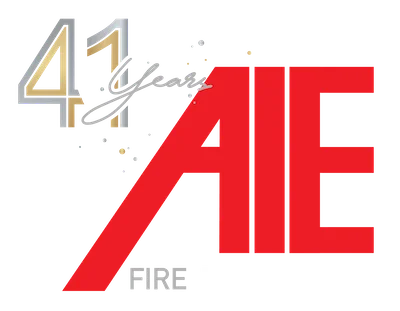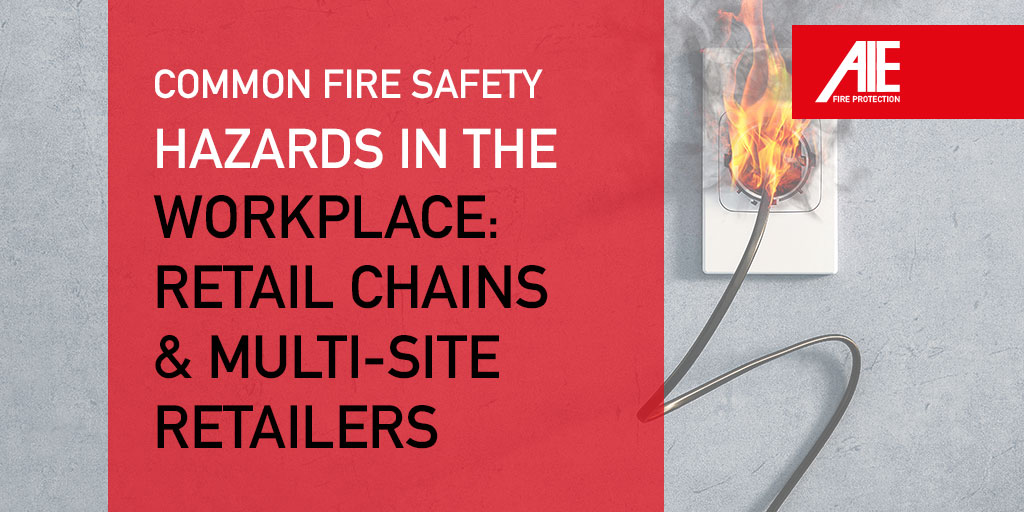Big-box retail stores, retail chains, and multi-site national retailers are vulnerable to hidden yet potential fire safety hazards in the workplace. In day-to-day store operations, it is easy to take precautions with the obvious fire dangers, like avoiding open flames, but did you know there are more subtle yet common fire hazards in retail stores that hide in plain sight, especially in stores that offer a variety of items?
What are the Common Potential Retail Fire Hazards?
Retail hazards are lurking throughout the retail environment. Read on to learn the location of the unseen, but common fire safety hazards in the workplace and how to easily decrease the potential for fire threats and damage.
Electrical Sources & Sockets Fire Danger
One of the leading causes of commercial fires and one of the most easily avoided fire hazards is electrical source fires. Loose wiring, damaged plugs and power sockets, and overloaded power sockets can be problematic and represent major hazards in the retail industry. Overloading power sockets and overheating is increasingly common due to the number of computers, the use of extension cords, and too many appliances plugged into the same source. When an overheated socket or plug encounters paper, a fire can start rapidly.
What You Can Do to Prevent Retail Fires from Electrical Issues:
Practice electrical fire hazard prevention in retail stores by requiring each department’s manager on duty (MOD) to inspect electrical outlets, sockets, and plugs daily. Be sure to also clean away dust and debris and check your electronics and appliance departments for faulty wiring or overload.
- If extension cords are in use, to ensure that they are in regulation with National Fire Protection Association (NFPA) codes, follow these rules:
- Where extension cords are used for other than temporary purposes, additional permanent receptacles should be installed to accommodate the power strips.
- Power strips that are plugged into other power strips (daisy-chained) should be removed, because such arrangement is prohibited. Relocatable power strips are for temporary use and should not take the place of permanently installed receptacles.
- Address any lighting issues – burnt out bulbs, flickering, or frequent malfunctions. Keep flammables away from hot light bulbs or switch to LEDs to avoid heat altogether.
- Have electrical engineers regularly inspect the building’s wiring and electrical sockets and address any issues immediately.
- Never let employees leave electrical equipment or machinery plugged in or on overnight unless necessary.
- Implement a safety plan for kitchen/cooking appliances, which should include unplugging when not in use.
- Always keep paper and flammables away from electrical sources.
The leading causes of fire in stores from 2014-2016 were: cooking, 31.6%; electric malfunction, 11.4%, and heating, 9.4%. Fires occurred most frequently between 1-7 pm. – The U.S. Fire Administration’s National Fire Incident Reporting System

Dust Can Be a Common Fire Hazard in Retail Stores
Dust is common in a retail environment, but most people don’t know it’s also a threat to fire safety. These potential fire hazards in the workplace are everywhere. Shipping boxes generate dust, the furnace and HVAC create dust, merchandise itself, dirt and pollen from foot traffic, and many other activities generate dust that when built-up on surfaces, can be ignited by a spark. Be sure to minimize dust in your retail chains.
What You Can Do to Prevent Retail Fires from Dust:
To stop dust from sparking into a fire, keep your stores as dust-free as possible by implementing a daily dusting policy in each department. Additionally:
- If your multi-site retail facilities have high, open ceilings, exposed ducting, and ceiling fans, create a team at each location to clean the highest visible areas on a regular basis (at least monthly).
- If there are areas in your stores with heavy wood, plastic, or metal dust, it is especially important to install extraction fans and keep dust to a minimum.
Though it’s impossible to remain dust-free, a daily effort will go a long way toward maintaining retail fire safety.
Gas Lines & Flammable Risks
Most large retail stores encounter extreme commercial fire hazards with gas lines, liquid gas, or propane that run their heating and cooling sources, motors for overhead doors, forklifts, trucks, and other equipment, as well as kitchen appliances, and in some cases, tools and outdoor appliances. These and other flammable liquids can ignite instantly when in contact with a spark or open flame. If these are in your stores, they can represent significant retail hazards.
Many multi-site national retailers also sell flammable, combustible, and hazardous materials and have entire departments dedicated to them – paint, automotive, lawn and garden, indoor and outdoor cooking, etc. Paying extra attention to these areas of your stores when it comes to fire safety is a must.
What You Can Do to Prevent Retail Fires from Gas:
To protect your retail customers, staff, and business from the extreme fire risk posed by flammable sources, be sure to train and educate all employees on storing, handling, and using them, and follow the strict protocol mandated by OSHA1926, NFPA30, and your local Authorities Having Jurisdiction (AHJ) guidelines. These mandates include, but are not limited to:
- Implementing a comprehensive flammables safety program and teaching it to employees.
- Inspecting and maintaining gas lines regularly.
- Locking liquid gas and propane tanks in flammable cabinets, away from open flames or combustible materials.
- Safely storing/handling/selling other flammables and solvents, such as lubricants, aerosol cans, petroleum-based products, and some cleaning chemicals.
- If there is a chemical spill, blocking off the area, cleaning it up, and disposing of it right away in accordance with code.
- Keeping all paper, cardboard, trash, and cigarettes away from these sources.
- Requiring fire safety and flammable liquids training annually.
On the sales floor where flammables are sold, look for any electrical issues, debris that should be disposed of, excess dust, open containers; check for unusual vapors and tripping hazards, and make sure there is proper ventilation.

Trash & Cigarettes Ignition Risks
Retail stores have massive amounts of trash – all of which is incendiary. Cardboard, plastic, paper, peanuts, and other packing materials can build up and be at risk of ignition. Break room, warehouse, and storage areas also generate a copious amount of trash. If it is not disposed of regularly and properly, trash can create plenty of fuel for a potential fire should it come into contact with a spark or heat source. A discarded cigarette near rubbish could result in a rapid fire that could be out of control in seconds.
Which leads to smoking. This is another obvious but rarely considered fire hazard. Smoking inside or outside your retail chains and stores, by either employees or customers, can be especially hazardous if it is allowed to take place near areas where flammable materials are present. Discarded cigarette butts are a fire waiting to happen.
What You Can Do to Prevent Fires from Trash:
Stop trash from overflowing and put it in the dumpster as needed rather than just near the door. This maintains clear doorways and evacuation paths in case of emergency. This also stops paper and other flammables from coming into contact with equipment such as electrical outlets, the furnace or air conditioner, electric appliances, overheated motors, and open flames. Maintaining clean, uncluttered sales floor and employee work areas keeps the fire load to a minimum.
As for cigarette fire hazards, designate smoking areas away from main buildings and flammable items. Keep trash dumpsters and bins away from these areas, make designated cigarette receptacles obvious, and post signage to remind smokers to extinguish cigarettes properly.
In the U.S., cigarette fires cause close to 1,000 deaths and 3,000 injuries each year. As the ignition source in fires responsible for over 20% of all fire deaths, cigarettes are the nation’s largest single cause of such deaths. – National Fire Protection Association (NFPA)
Human Error & Fire Safety Training Mishaps
One of the most common causes of all fires is human error. This can come in the form of negligence, accidental mishaps, improper use of equipment, or lack of fire safety training.
The primary step to protecting your retail business and its occupants from fire is to educate each staff member on the causes of fire, encourage vigilance and a daily fire-safety routine, hold annual, mandated fire-safety training sessions, and urge employees to report any potential fire hazards right away.
What You Can Do to Prevent Fires from Errors:
Proper fire safety training for your chains or multi-site retail stores is the only insurance you have that your employees know how to prevent fires, stop fires, and evacuate calmly in the event of a fire. Here are several ways you can minimize fire risk with daily habits and education – it is your first line of defense.
- Make prevention part of your daily routine.
- Keep flammables away from electrical outlets, flames, and static electricity.
- Don’t overload electrical sockets.
- Make inspections and repair and maintenance of electrical wires, gas lines, and all fire protection equipment part of your regular routine.
- If you have a kitchen or breakroom with a hot plate, toaster, or cooking surface, keep it grease-free, clear of clutter, and unplug appliances when not in use.
- Implement a daily checklist that must be initialed by employees assigned to clean/dust/remove debris throughout the day and ensure everything is off and/or unplugged at closing time.
- Stop trash from overflowing and put it in the dumpster as needed.
- Keep doorways and evacuation paths open in case of emergency.
- Designate safe smoking areas away from the building and anything that could ignite.
- Enforce all fire safety policies and uphold the mandated annual safety training for all employees.
Explore even more fire safety tips and potential fire hazards from our experts! Taking these tips seriously keeps your customers, employees, and retail business safe while providing peace of mind for you and reducing overall retail hazards.
From 2014-2016, an estimated 100,300 non-residential building fires were reported to U.S. fire departments each year, causing an estimated 90 deaths, 1350 injuries, and $2.4 billion in property loss per year. – The U.S. Fire Administration’s National Fire Incident Reporting System

Avoid Retail Fire Hazards & Ensure Fire Safety in the Workplace
Fire risk is higher than most retail store owners and multi-site managers realize. There are many potential fire hazards in the workplace. By sharing these common fire safety hazards and the steps you can take to lower the chance of fire in your retail locations, AIE hopes you see just how easy and cost-effective, yet critical, fire prevention, protection, and safety measures are to minimize fire danger, keep your customers and staff safe, and add to the longevity of your business.
If you have questions about commercial fire safety tips in this article or would like to partner with one nationwide fire-safety source that specializes in mid-size chains and multi-site national retailers to big-box retail facilities, contact AIE today, 800-892-9863.
Information posted in our blog is merely for educational and informational purposes. While the information has been verified to the best of our abilities, we cannot guarantee its total accuracy, and it should not be considered legally binding advice. This blog is not intended as a substitute for professional advice, and should you decide to act upon the information, you do so at your own risk.


Recent Comments